Sid Meier's Alpha Centauri - The Free Drones
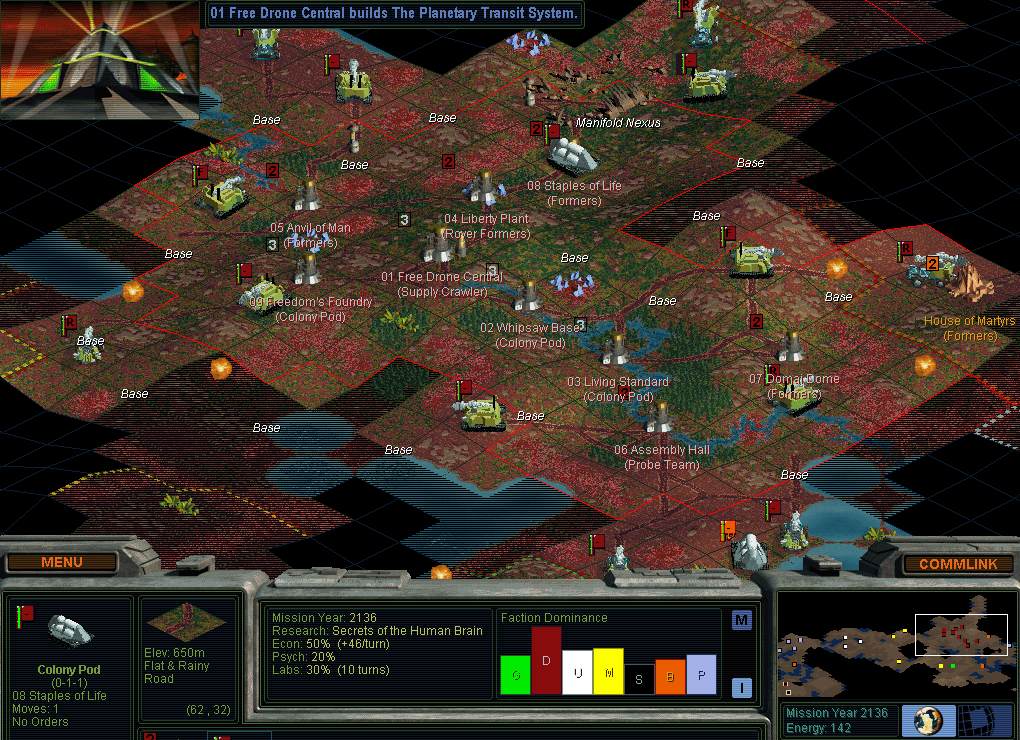
I completed the Planetary Transit System in year 2136. Actually one turn faster than the University game, thanks to the industry bonus to speed up construction of the supply crawlers. With fewer bases currently than the University game (9 vs 13)... but this game's equity exists in the form of those six rover formers out building roads, you can see how each of them has built about four squares of roads outwards in every direction. As always, I constructed the PTS by building 9 supply crawlers, and temporarily fake-switched out of Wealth SE to get better industry value for adding them into the project.
And building the PTS at only 9 bases was less of a micromanagement tangle than usual. I haven't described this, but every time I build the PTS I do a lot of work on that turn to handle all the bases jumping to size 3. During production, scroll-ahead from the HQ to every other base in line, to best arrange all the new population among the workable tiles, and partial-rush as many colony pods as possible to exactly the right amount after determining the base's new mineral production. The whole thing is a headache because you can't save/load during production upkeep, and I usually end up reloading to redo it several times until getting everything perfect. Anyway, here you can see that that five of the nine bases already dropped to size 2 after building a colony pod immediately right now.
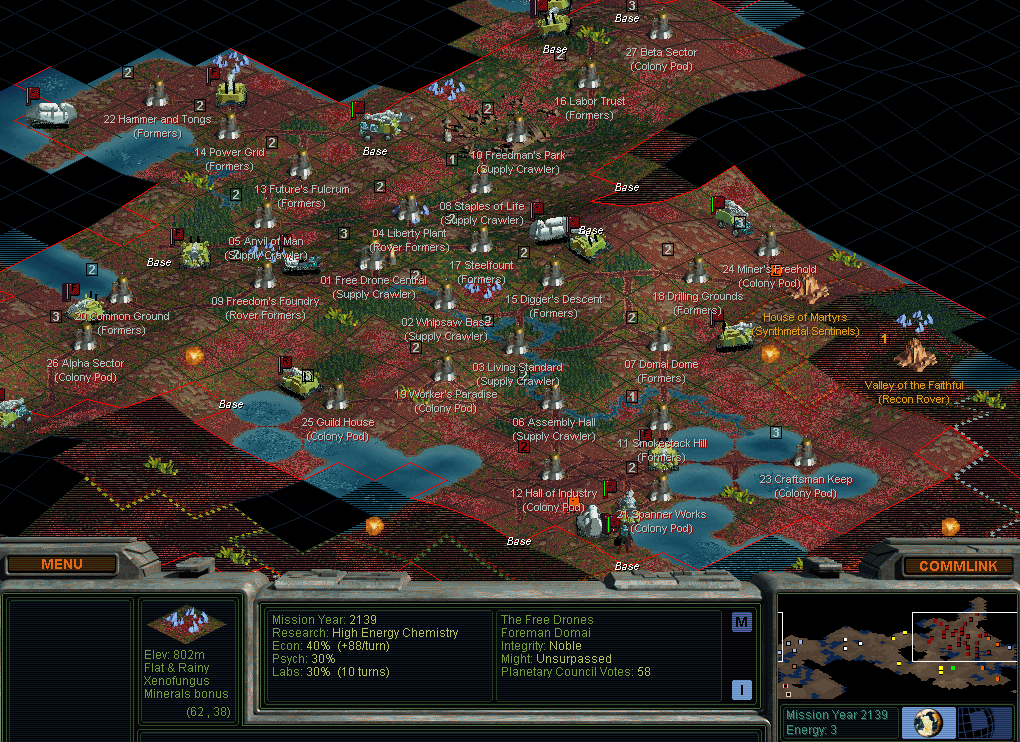
Next overview, in year 2139, to compare with the University at the same date. As described in other games, every new base would start with its 10 free minerals and rush-buy the next colony pod right away on its first turn of existence. What's different here is the rover formers. With the roads already in place, every colony pod can advance two squares, plant its base, and rush-buy the next pod all in a single turn each. I exploded my base count to add 18 more in just four turns since the PTS!

It's hard to concisely describe exactly how much the rover formers speeded up the expansion. Here's an attempt visually. The normal case is the left side of that illustration: marching a row of PTS bases takes three turns per base (shown is six turns for two cycles), one turn to plant and build a new pod and then two turns to move it two spaces.
The right side shows how a rover former doubles the speed of the whole cycle. With it we get two bases every three turns instead of six! On the same turn the base is founded, the rover former advances through that base tile and builds a road on the next square. On turn two, the rover builds a road on the next tile as well, just in time for the colony pod to reach that tile and settle all in one turn. Then on the third turn, the rover builds one more square of road, so the colony pod can advance through that to the tile beyond.
Realistically, that wasn't perfect. The pod's last advancement is a 2/3 chance of success based on its fractional movement remaining. And the pace of building roads assumes flat tiles; rolling tiles take two turns instead of one, which happened sometimes, plus of course rocky or fungus could get in the way. Overall I felt the rover formers made for expansion roughly 1.6 times as fast in each direction.

But here's another angle that multiplies my expansion speed again. Each "marching" line of new bases advances linearly. But on a 2D plane, the reachable area expands quadratically. I drove a "spike" directly away from my core in several directions. As the spikes got longer, there was more space between them. So some of those bases also built a second colony pod, to fill the space between those spokes. If each spoke was advancing linearly 1.6 times as fast, then the reachable area and total base count expands at 2.56×, two-and-a-half times the baseline. And for these "sideways" expansions, the timing wasn't critical, as there wasn't a long line of subsequent bases depending on each, so it was okay if several just starved to size 2.
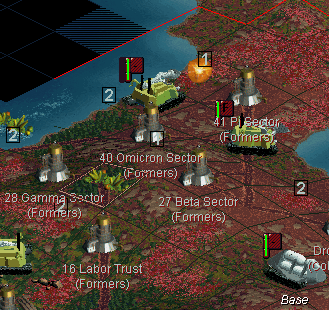
And this shows an example of how I'm supplying the food. A base at size 3 from the PTS needs 6 food to not starve, even if it's producing a colony pod to drop the size on that same turn (starvation is checked first.) 6 food means two from the base square, two 1-food tiles (forest/moist/ocean)... and at least one 2-food tile. I did this sort of thing everywhere: cluster as many as five bases within reach of a single nutrient-bonus or rainy tile, like the highlighted one here. Each base would use that food for that one critical turn to not starve while rushing a colony pod to drop to size 2, then survive on two 1-food tiles, while the next base newly planted at size 3 then took that food for its one critical turn, and so on. Also, the roads laid by the rover formers speeded up terraforming as well; regular formers would save a turn on moving into those already-roaded tiles to start planting forests.
But for a few (about one out of every five base locations) there just wasn't any food in the vicinity at all, like Pi Sector here. So then to just eat the starvation penalty was the most expedient way to keep moving, faster than waiting for formers to build a farm. (The perfect approach would be to also bring along a rover supply crawler, able to rehome to the new base and move back along roads to a food tile to crawl, but I just didn't do that.)
Although I actually didn't really care much about losing population from starving. There's not that much difference between a size-1 or size-2 base, since most of the value is in the base center square at +3 economy rating. The more annoying part was that starving skips the base's entire turn with no mineral or energy production step, which would delay that next colony pod one turn and therefore everything downstream from it as well. So when all the space around one such food tile filled up, I often walked a colony pod an extra turn to reach the next available nutrient or rainy tile (and often recouped that turn by the accompanying rover former meanwhile building the next road.) I was able to avoid starving for most of my bases in this way of making multiple uses out of each good food tile.
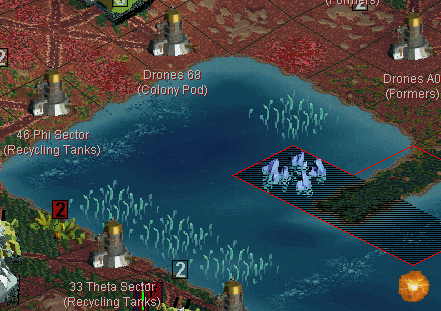
Also I used a few sea formers to plant kelp for coastal bases. This worked a lot better than land farming; the much more mobile sea formers could move ahead fast enough to start and finish planting kelp by the time a land colony pod got into position to use it. And again one such tile could be used in sequence by multiple bases.
Now, these colony pods are where the industry of the Free Drones kicks in bigtime. I'll illustrate this tabularly (including Wealth's industry in all cases):
| Pod cost | Free minerals | Net cost | Energy cost | |
| Standard | 27 | 10 | 17 | 48 |
| Free Drones | 21 | 10 | 11 | 28 |
That +2 Industry blows up into saving almost half the energy cost of each colony pod! First it greatly narrows the differential between the 10 free minerals and the cost of the pod, by over a third from 17 to 11. Then that savings further blunts the quadratic cost formula for rushing units. And then I would even rush most of these pods fully rather than partially, so that the next build order (terraformer) would come up to 10 minerals faster to be rushed sooner as well.
We can compare this to the Hive running Planned. That would be the same industry bonus for the same discounts... but without +3 Economy, the Hive wouldn't make enough energy for the rushing. The Hive would also have to spend some of those saved minerals on police units. Really, the Hive-Planned is weaker than it should be because half of what should be their bonuses go to waste, only the industry matters, the growth is basically moot and little use with the PTS.
Finally, I even twigged to one more trick that I was shocked had never hit me before. I could save even more buying these colony pods with a temporary SE switch to Planned. Upon founding a new base, the progress towards its colony pod would be 10/21 minerals, costing 28 energy. In Planned, it's 10/18, costing 19 energy, and then you can switch back to Free Market to rush the last 3 minerals for 6 credits, for a total cost of 25. (The game says it doesn't allow multiple rushes in a turn, but it actually does allow rushing again as long as the previous rush was full rather than partial.) So we can circumvent part of the quadratic-cost formula by breaking up the rush into multiple components. Saving 3 credits per pod sounds small, but that's more than 10% and does add up. (All these shenanigans are why all the later Civ games implement production modifiers as yield multipliers rather than cost discounts.)
It was mostly colony pods of course, but this works for rushing any kind of unit. (Doesn't matter for facilities because their cost is linear not quadratic.) It would also be possible to skip those last 3 minerals and let the base's normal production complete that, but here I actually wanted to full-rush as much as possible, so the turn's production would overflow and go into the next build item (former) sooner too.
Now for drone control. At first, starting with the PTS in 2136, I had to run 30% psych slider for a little while. Then my core bases finished the supply crawlers to crash-complete the Human Genome Project, in 2143. That makes for perfect drone control at 0% psych, and here's it's time to describe fully what's going on with drone management.
First to cover this detail: The base non-expansion game doesn't have the Free Drones' drone-reduction ability. So I edited the faction to have the Peacekeepers' talent ability instead, at 1 talent per 20 citizens so there would never be a second one. I think either faction ability is functionally identical throughout everything I'll do in this game: the talent won't ever create a golden age, I won't send out any more pacifism-causing units, and nerve stapling will obviate everything later anyway. And I specifically tested in SMAX to confirm the faction abilities behave exactly the same in the situation described here.

The chart on the left shows what most factions would be doing at this point. We have the Planetary Transit System (listed as Facilities) and Human Genome Project, but there is no other broad-based drone control solution available until much later. Most factions have no good way to manage drones at size 2 even with those projects, once into enough bureaucracy to cause that bright-red "superdrone", which consumes the HGP's effect but only upgrades into a regular drone. Every possible option (psych slider, police units, doctor specialist, rec commons, network nodes + Virtual World) incurs a substantial real or opportunity cost.
But the chart on the right shows what happens with either the U.N. Peacekeepers or the Free Drones. This all works because of a certain detail of the bureaucracy drone mechanic: superdrones are capped so that the first citizen in a base is never one, so a size-2 base only ever has one superdrone. It turns out this cap applies before the Peacekeepers' free talent or Free Drones' drone reduction, so the faction power goes into negating that only superdrone. In short, a size-2 Lal or Domai base never has any superdrone at all. Then the PTS and HGP make one of the regular drones into a worker then a talent, to balance the base perfectly.
That all works for a base specifically at size 2. Size 3 requires a doctor... but pulling any citizen off a food tile means such a base will starve unless it has access to two 2-food tiles, which few do. So I had to have most bases rush a colony pod right away on its first turn of existence, to kick out that third citizen and drop to size 2 before the base ever checks for drone riots. Same as I did back in my Morgan game, although that had to pay nearly double for each colony pod compared to the industry discount here.
I also added the Weather Paradigm as usual with supply crawlers, in 2146. From there I didn't need and wouldn't build any more secret projects until the Cloning Vats.
So now let's put all that together, the road movement and food supply and industry rushing and drone control. Here's the next look at expansion, in year 2150 to again compare with the University game:

Where the University had 44 bases, this game is out to an astounding SEVENTY-THREE. Look at that faction dominance graph, a perfect straight line upwards. My expansion never slowed or curved, I maintained a constant pace of five new bases per turn for a very long period of time.
Presently I embarked on the other avenue of expansion: hostile conquest. As shown in that picture, Morgan, the Believers, and Gaia (to the south) all settled some bases widely spaced, as the AI tends to do. I was expanding so fast I just marched right through and surrounded each of those rival bases with my own.
Morgan was still a productive pactmate buddy so I didn't want to bother him, but now the others would meet their fate. I had actually declared vendetta on Miriam early on, at the U.N.'s request in exchange for a pact. Then I had induced vendetta from Gaia by stealing a tech.
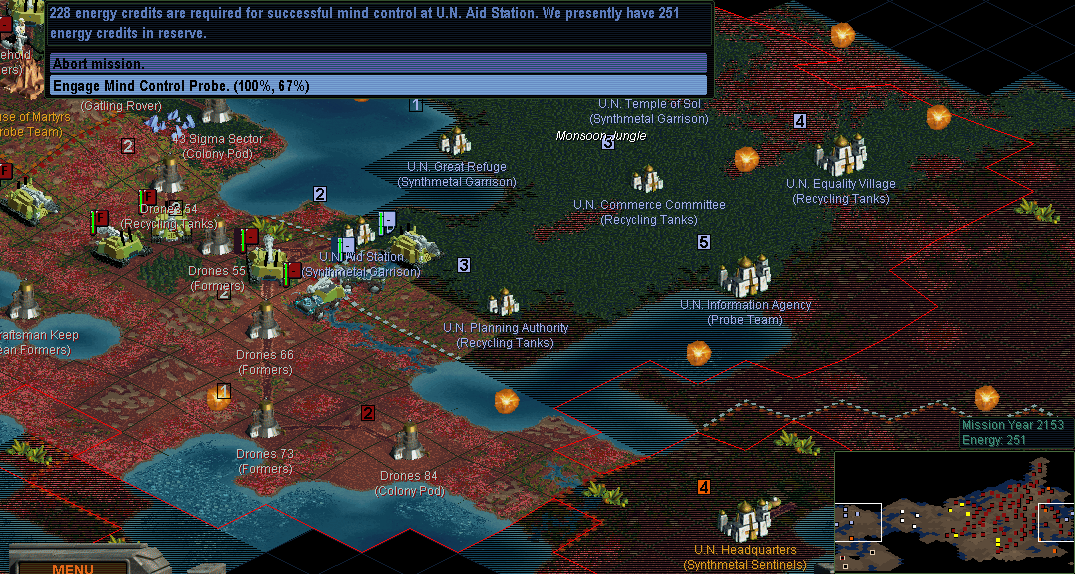
And against the U.N., I deliberately started an outright war of aggression. Obviously I wanted to take the jungle for myself. And the Believers had done me the huge favor of conquering U.N. Headquarters! Lacking an HQ makes mind control prices cheaper, so I started by simply buying the closest U.N. base. It came with a total of four units (one in the base, two south of it, plus the former), making it worth that price, since those units could then be upgraded for offensive combat right there on the front line. The former even had some partial terraforming turns invested that carried over for me! - it built a road on its rocky-river square in only two turns.
The 220 credits spent on that was most of my money for that turn. So here's how I could continue without interrupting the colony-pod rushing everywhere, still doing four or more every turn. Scroll-ahead via F4 during the next turn's production upkeep, after the earlier bases in turn order had produced their energy, to spend that energy on later bases building colony pods all right away still during the same turn's production step.
For a while in these wars, I only had laser-weapon recon rovers to fight with. That held each vendetta at a stalemate but I couldn't really make much progress against the bases. And Miriam sniped at and killed several of my formers around her base House of Martyrs inside my territory.
The breakpoint swing for these wars was Morgan researching Superconductor to trade to me. (I knew it was coming from infiltration, and had a probe ready to steal if he wouldn't trade, but he did.) That gives 5-attack gatling weapons, so a few gatling rovers easily turned the tide in all three wars. The gatling rovers cost a little more than I would have liked (four mineral rows, compared to three for impact rovers), but got the jobs done easily; no base had built a perimeter defense and no rival had gotten 3-strength armor. Gaia had one mind worm on defense that I built an empath rover to take care of.

I took surrender pacts from all three enemies. And there's one wild result: Gaia bought eleven techs from me for 25 credits each that she didn't have! Lal did the same thing, which came to a total of 550 credits out of nowhere, hah. This only happens like this after a surrender pact because a normally functional AI never has the patience to sit through eleven diplomatic proposals before cutting comms. (Sadly Miriam claimed she didn't want any of my techs.) And the other reason I made sure to feed Lal all my techs: his own research bar was just about to complete a tech for himself, so I could make sure he would get something new to give me.
Three submissive slaves means control of a guaranteed voting majority in the Council, so I repealed the UN charter to allow nerve stapling now, although wouldn't actually use it until the start of the population boom.
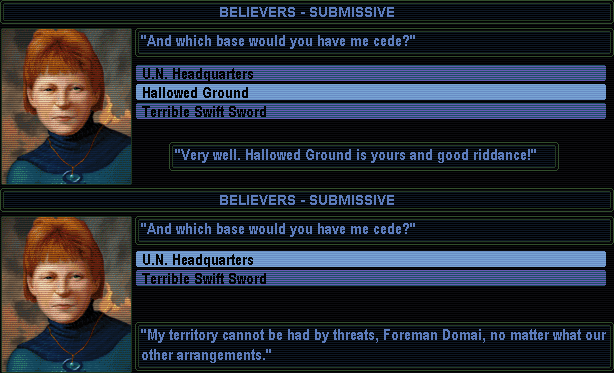
And I decided to see how far I could push the diplomatic option to demand bases from a slave "or else I shall cancel our Pact." Turned out that Miriam would cede one base but not a second. Lal did the same thing. So I guess one base is the limit for that. (Gaia had only her HQ so nothing to cede.) I think in general you can demand one forcible trade per capitulated leader and then no more threats will work.
The last question regarding these conquests is whether to nerve-staple the captured bases. (Even with the charter repealed, the original owner still counts it as an atrocity against their people, and breaks out of the submissive pact into vendetta.) I feel like I get this wrong every time this comes up: if I staple, I regret giving up the council vote and commerce partner; if I don't, I regret having to manage drones in those bases with rec commons and such.
But this time I took a pretty good approach. With most of the captured Gaian and Believer bases, I built colony pods out of them until the base reached size 1 and disbanded and I could rebuild it as my own native base, even freshly at size 3 again via the PTS. I did keep one larger Believer base (with no room nearby to settle any colony pods from it) and built rec commons. For the nice big U.N. bases in the jungle, I decided I really wanted to keep and staple them, so eventually I did so and then just conquered his last base to eliminate him.
The one area not soaring spectacularly was technology, as should be expected from the Free Drones' faction penalty. At year 2150 I was still considerably behind the tech rate of my University game, at 200 labs per turn compared to 325. That probably couldn't ever catch up on just horizontal expansion, since even with nearly twice the bases, the outermost ones halfway across the map from my HQ were now almost at the limit of losing all produced energy to inefficiency.
I had a tech path planned, but in the short term it was best to schedule my own research around what the AIs were doing for me to acquire from them, with the governor infiltration telling me what was coming. I had first set my own research to Secrets of the Human Brain for a while (after Industrial Automation), as a placeholder since I expected I could acquire that from Gaia or Morgan in order for my own research to transfer to something else. That happened, and my self-research path became the techs that no AI was doing: Neural Grafting, High Energy Chemistry, Gene Splicing.
I picked up a LOT of techs from the AIs: Doctrine Flexibility from the U.N., Secrets of the Human Brain and Ethical Calculus from Morgan (though he unusually required 100 credits for each even when I had my own tech to trade), Superconductor also from Morgan (after deliberately feeding him his current research of Gene Splicing to get him to change to a new tech), Polymorphic Software and Optical Computers and Adv Military Algorithms all from the University, Nonlinear Mathematics unexpectedly from Sparta, Centauri Empathy (stolen) from Gaia, and Doctrine Loyalty (also stolen) from the U.N.

As usual, here's an illustration of my tech path. Now I was up to the first step of my midgame plan, marked in light green to Bio-Engineering. That enables clean-reactor formers, which I hardly used in most of the other games here, but this time they seemed the right call. The Free Drones are the best at building lots of units such as formers, of course. But industry rating works against you in terms of supporting those units, since each mineral paid into support represents a bigger fraction of each build item. Every core base had by now built the two free-supportable formers and most also had recycling tanks, so clean formers seemed to be the next best build option. A differential of just 7 minerals for new formers to be clean would pay back quickly enough.
This linked with my terraforming plan, which was almost all forest punctuated by boreholes. The Free Drones want to go big on mineral production, with the industry discount effectively multiplying it all. This plan was different from the University game, which didn't push minerals much and went maximum food everywhere instead for max population. As I described in that University report, a key principle is productivity-per-former-turn, and there's no better metric for that than a self-expanded forest that cost zero turns. Forests also produce 1 energy that a farm doesn't, which along with borehole energy would significantly help the Free Drones in getting up to the Cloning Vats.
What forests don't do is supply food for population-booming. Plentiful minerals and industry, and a need to get food from forests... that of course means tree farms. So next I researched Ecological Engineering and Environmental Economics, with the plan to start building tree farms that should complete just about as we would reach the Cloning Vats. And the +50% economy from the tree farms is also significant, as money spent on rushing items is also virtually multiplied by the industry discount. Finally, those are also the techs to uncap tile yields for minerals and energy, so of course now the clean formers were also drilling boreholes after they'd finished the forests in an area.
Recycling tanks are the other way to turn minerals and industry into more productivity. I think I now clearly understand how to state the value of recycling tanks: it all depends on whether the food is doing something useful. Population booming is the obvious positive case, of course. The nonpositive case is raising a base's food surplus by just +1 while not booming, which really does very little, it'll take forever to grow (10 or 20 turns is forever.) But now I came to realize the other important case, to cover a food deficit and support working a foodless tile. That happened a lot here, in almost every base. Usually a size-2 base works two forests at break-even food. With a recycling tank, it could switch one laborer from a forest to a mine or borehole instead, meaning the tank virtually yields a net payback of 3 or 5 minerals per turn, a fast enough payback horizon to be useful.
Following Bio-Engineering, my path is indicated in dark green for the environmental techs, then yellow up to Biomachinery for the Cloning Vats. All the gray boxes came in a flood of trades and thefts. Later Lal also gave me Intellectual Integrity (his research right after I took his surrender), which I fed to Morgan to get him to change to a new tech again, which turned up Cyberethics for me. Then would come the usual progression to Orbital Spaceflight and Fusion Power, then the lategame drive to Digital Sentience.
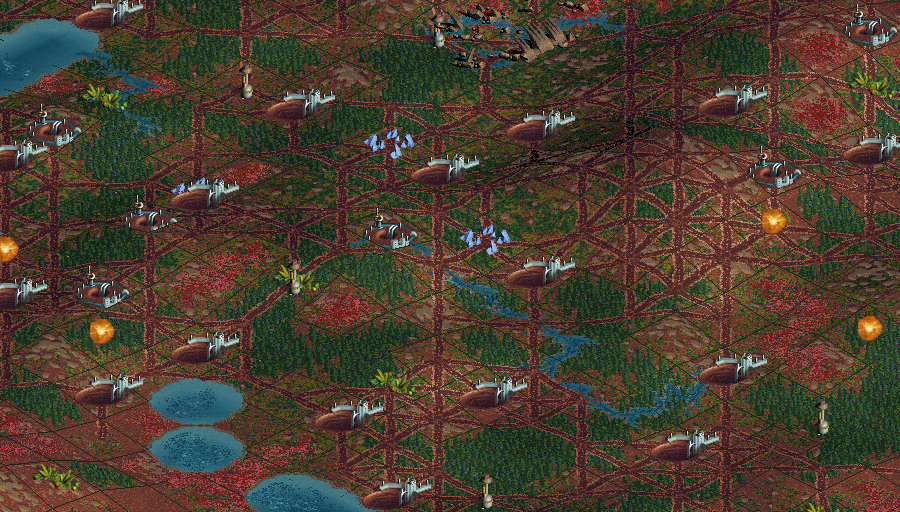
Here's a look at the terraforming around this time. Mostly forest, and over time it would self-expand into many of the empty and fungus tiles. Some boreholes, but I didn't plan out a grid at all, just built them on the most expedient tiles, that were rocky so unsuitable for other purposes and that didn't need elevation/slope adjustment. A bit later then I did decide I had enough formers available to adjust elevation for boreholes in most cases where doing so was possible. Rocky tiles that were constrained from boreholes got mines at first, but then I changed my mind and found myself with enough former labor to be worth the terraform-level action to fix the rockiness and convert to forests instead. 2 food from each tree-farmed forest means an additional specialist down the road, which is significantly higher yield than a mine.
Presently, in year 2164, I decided it was time to get into Democratic politics. This was earlier than in the University game, which didn't until after pop-booming for a while, but it felt necessary here. I had almost filled up all the space on the landmass, so I could live without the 10 free minerals for the last few new bases. I needed the Efficiency earlier this time, since my empire was so big that the outermost bases were losing almost all their energy to inefficiency. I needed to get up to the Cloning Vats faster and this was the way to do it. Adopting Democratic saved about 240 energy per turn worth of inefficiency losses, enough for the overall value to roughly break even against the support penalty. But the main purpose was to tilt the labs slider to 70% with a tolerably small unbalancing penalty. The two effects together improved my overall tech pace by about half again, speeding up from three turns per tech to two.
The support at every base would be a drag but tolerable, I thought. Except... wait a minute... here's a crazy bug/loophole/trick to save all the support!

I had out of curiosity checked the F7 screen to see how many formers I had. Zero? Okay, that must mean I have exactly 256 and the counter overflowed. That sort of thing is not at all unusual for this game or many of its age. Probably a harmless display bug... or is it?
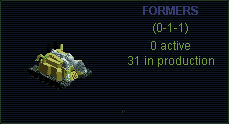
The unit workshop also says I have zero formers. Now a fiendish exploit idea hit me. What if I tell the workshop to upgrade all "zero" of my formers, to clean reactors?
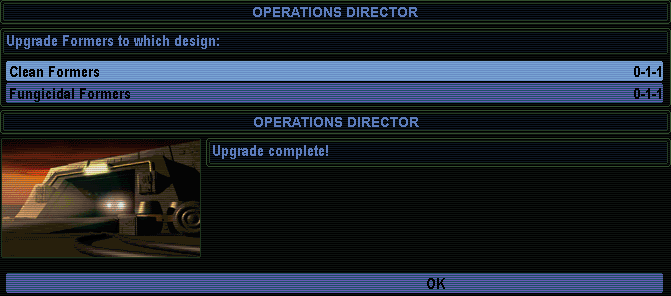
HAH HAH HAH HOLY SHIT THAT WORKED! The game charged me zero credits (the popup showing the cost never appeared) and still upgraded every terraformer!! I got 256 clean reactors for free!
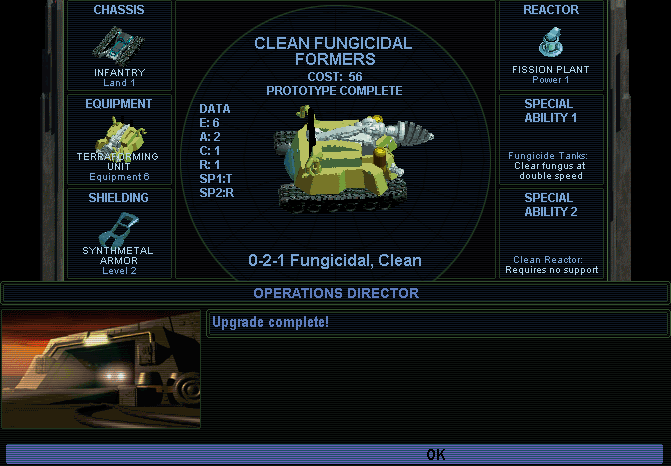
And here's an even better way to do all that, which I reloaded to do instead. I could tack on even more stuff for the free upgrade, the Fungicidal special ability and also throw on synthmetal armor. But the further effect is to isolate these 256 units as one slot in the workshop. This means I can do this again later, as long as I still have exactly 256 of the same unit (build only to replace any killed by worms), I can do it again to upgrade 256 formers to the Super Former ability for free also when that arrives.
(And how about deliberately breaking this exploit to the max? Intentionally build 256 scout patrols, free-upgrade them to the most expensive model you can design, and disband them for half mineral value towards whatever you want. I could do that in about three turns here if I wanted. I decided not to, both for sanity-savings' sake, and because if you're going to do that then the game plan should be built around it from the beginning to do it quite a bit sooner. So in the end I opportunistically took advantage of this overflow when it came up, but didn't deliberately set out to trigger it.)
And as before, we'll cut onto a new page for the population boom through the finale.